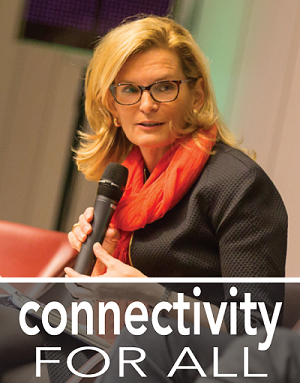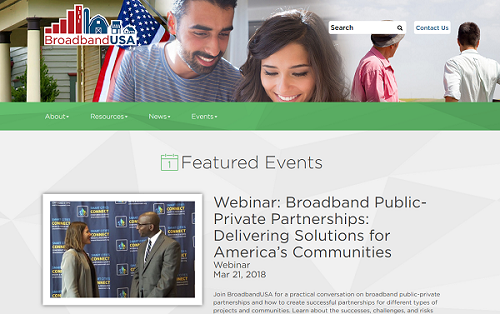NTIA Blog
Making the Case for Using Computer Simulations to Gauge Spectrum Interference
As demand for spectrum for commercial use continues to grow, policymakers are exploring spectrum sharing as a way to expand capacity while still fulfilling the needs of federal agencies. This model can work only if rules are designed to maximize the value of spectrum resources without compromising the quality and reliability of telecommunications.
To minimize the probability of interference, spectrum managers separate systems in distance and frequency. The amount of separation is determined by interference protection criteria (IPC), which can be estimated through analysis, measurement, or computer simulation.
Although the analytic method is fast it can also be highly inaccurate. Accurate and repeatable measurements may also be difficult to obtain. One reason is that IPC measurements are often hindered by restrictions on equipment availability. In some cases, spectrum managers need estimates for systems that have not been built yet, so measurements are not possible. In other cases, the systems can only be tested for a brief period of time to avoid service interruptions.
To overcome the limitations of measurement, NTIA’s Office of Spectrum Management and Institute for Telecommunication Sciences (ITS) have made significant investments in computer simulation capabilities. This has provided a tool to use when measurements are not possible, especially when trying to assess a multitude of spectrum sharing scenarios. ITS is NTIA’s spectrum engineering laboratory.
Celebrating the Nation’s Public Safety Telecommunicators
April 8-14 marks this year’s National Public Safety Telecommunicators Week, when we take time to appreciate and thank the dedicated professionals who staff the thousands of 911 centers throughout the nation. These devoted public servants work quietly on the front lines of emergencies, serving as “the first of our first responders.”

We may take 911 calls for granted today, but it was only 50 years ago that the first emergency call was completed in Haleyville, Alabama. We’re now on the cusp of improving our 911 system by providing our highly trained professionals with the advanced tools they need to do their jobs in the 21st century.
Through our joint Implementation Coordination Office, later this year we will be rolling out a revamped 911 grant program to provide states and territories with federal funds to upgrade their 911 operations to keep pace with Next Generation communications technologies.
Please join me this week in recognizing the men and women who work behind the scenes, often without recognition, to answer our 911 calls, dispatch our first responders, and protect our lives and property.
NTIA Launches Updated BroadbandUSA Website with Collaborative Online Portal
Today, NTIA launched its revamped BroadbandUSA website -- broadbandusa.ntia.doc.gov -- to inform the public about NTIA’s work to expand broadband connectivity through educating, convening and assisting stakeholders. The new website serves as a one-stop shop for broadband information around the federal government and makes it much easier for users to find events, webinars and publications they need.
Working through the Broadband Interagency Working Group, NTIA created the site to enable federal agencies that support broadband connectivity and digital inclusion to publicize resources through a one-stop online portal. The site is intended to help communities and their private local exchange carrier and Internet service provider partners find resources and funding to support their local broadband efforts by providing information on federal resources, with links to federal grant programs that may fund broadband deployment and adoption projects.
Building Digital Access -- NTIA Partners with Tennessee on Broadband Summit
Nationwide broadband connectivity is the aspirational goal bringing together broadband leaders for the March 20 Tennessee Broadband Summit in Nashville. The event, sponsored jointly by NTIA and the Tennessee Department of Economic & Community Development, is an all-day program with workshops and problem-solving presentations from industry, state and local leaders, and community groups working to build connectivity options throughout the state.
Strong leadership at every level of government can lead to increased broadband deployment. New opportunities through the Tennessee Broadband Accessibility Act and other state and Federal initiatives are vital tools that can help increase broadband accessibility. Also encouraging is the increase in broadband leadership from states, as evidenced in the strong participation at a recent meeting in Washington, D.C. of state broadband leaders across the country to discuss the types of challenges, programs, and investments that are happening at the state level.
At the federal level, President Trump has made broadband a key priority. When he was in Nashville earlier this year, the President issued executive orders to streamline permitting, remove regulatory barriers, and make more federal towers available to commercial service providers. We have made progress in each of those areas.
Initial Estimates Show Digital Economy Accounted for 6.5 Percent of GDP in 2016
Electing Doreen Bogdan-Martin Would Be a Historic Step Forward for the ITU

For more than 100 years, March 8 has been celebrated as International Women’s Day, honoring the achievements of women and advocating for greater gender parity.
While women have made great progress in the past century, from the voting booth to the boardroom, there are still many institutions that haven’t kept pace. For example, in its 153-year history, the International Telecommunication Union (ITU) has never elected a woman for any of its five elected leadership roles.
This year, the voting members of the ITU have a chance to take a significant step forward by electing Doreen Bogdan-Martin as Director of the ITU Telecommunication Development Bureau, or D-Sector. Bogdan-Martin is an ITU veteran and former NTIA official who will bring dynamic leadership to this important body.
The ITU, originally founded to coordinate telegraph signals, is responsible for assigning global spectrum and satellite orbits, which are key functions for U.S. space and national security policy. The ITU also promotes access to technology and develops technical interconnection standards.
ITS Spectrum Efficiency Report Examines the Past, Looks to the Future for New Solutions
Every new innovation in connected devices promises exciting possibilities for the future, but it also means greater demand for spectrum, a critical and limited resource used both by the public and private sectors.
NTIA is committed to ensuring that the government’s use of this valuable resource is as efficient and effective as possible. But what does it mean to be an efficient user of spectrum? And how can future systems make better use of spectrum? NTIA’s research laboratory, the Institute for Telecommunications Sciences (ITS), digs into these questions in a new report providing a thorough survey of the history of spectrum efficiency. ITS reviewed more than 50 years of studies examining domestic and international spectrum efficiency to hone insights for future research.
The report found broad consensus on fundamental spectrum efficiency metrics, which consider increasing productive spectrum use and reducing spectrum blocking. Studies also agreed that spectrum efficiency metrics are most appropriate for comparing similar spectrum dependent systems or for optimizing the deployment of similar systems within a frequency band.
Based on the research, ITS makes a number of recommendations addressing spectrum sharing, and suggestions for how best to focus future spectrum efficiency studies to enable the United States to maximize spectrum opportunities.
NTIA Grant Program to Help States and Territories Continue Planning for FirstNet Deployment
NTIA is pleased to announce the first award recipients of the State and Local Implementation Grant Program (SLIGP) 2.0, which will provide as much as $43.4 million to help states and territories prepare for FirstNet’s buildout of the nationwide public safety broadband network.
The Middle Class Tax Relief and Job Creation Act of 2012 tasked NTIA with establishing a grant program to assist states and territories with planning for FirstNet, a nationwide wireless broadband network for public safety that that launched last year under the leadership of Commerce Secretary Wilbur Ross. Under the original program, NTIA awarded $116.5 million in grants to 54 U.S. states and territories between July 2013 and June 2014. The funding was used to consult with FirstNet and perform outreach to public safety stakeholders. The original grants expired February 28, 2018, and many recipients spent less than expected, leaving leftover funds.
NTIA is reallocating these funds in a second round of grants, SLIGP 2.0, which will allow for a broader range of planning activities, such as assisting state, local and tribal governments in developing data sharing agreements, helping with the transition of public safety applications to the national public safety broadband network, analyzing coverage gaps, and convening stakeholder meetings at FirstNet’s request.
NTIA Identifies 3450-3550 MHz for Study as Potential Band for Wireless Broadband Use
Americans rely on broadband Internet access to stay connected, to conduct business, to interact with the government, and for entertainment. Our nation’s broadband needs are increasingly wireless. Whether it’s 5G wireless technologies that promise to deliver dramatic increases in wireless broadband speeds and bandwidth, or the unlicensed technologies we place in our homes, businesses, and communities, wireless broadband technologies are paving the way for transformative changes that will improve health care, advance manufacturing and benefit public safety.
America is the world’s leader in Wi-Fi and 4G LTE and we have claimed an early lead in bringing 5G to reality. It’s essential to American competitiveness that we maintain our leadership in all of these areas. This is a Commerce Department priority under Secretary Wilbur Ross, who understands that to fully realize this potential, we need more spectrum to support broadband data access across the electromagnetic spectrum.
To meet this growing need, NTIA, in coordination with the Department of Defense (DOD) and other federal agencies, has identified 100 megahertz of spectrum for potential repurposing to spur commercial wireless innovation. This spectrum, the 3450-3550 MHz band, is in the mid-frequency range and could be a key asset in our nation’s broadband spectrum inventory.

